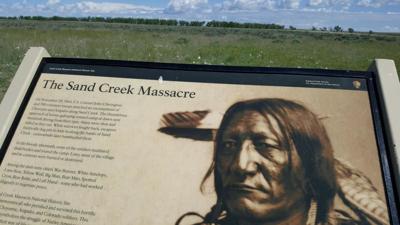Should a Colorado town be named after a despicable villain of our state history?
Be careful with your answer. It is valuable to remember the evil we want to forget.
Col. John Chivington oversaw an 1864 massacre in eastern Colorado and lied about his sinister deeds. He inflamed The Plains Wars, causing hundreds of needless deaths. The United States was creeping westward with vicious cruelty, but Chivington still managed to make a distinctive name with his barbarity. He serves as a forever warning.
At dawn on Nov. 29, 1864, Chivington led a force of 675 cavalrymen into an encampment of Cheyenne and Arapaho. The Native Americans gathered around the American flag and waved white flags. Hundreds approached Chivington and the cavalrymen. They were begging for mercy.
Chivington attacked anyway. His forces killed 240 Native Americans, including 150 women, children and elderly. Then, the corpses were mutilated. The crime is known as the Sand Creek Massacre.
I know some of you believe it wrong to apply today’s standards to the past. But the word “massacre” was immediately used to describe Chivington’s actions. Some standards are eternal.
“Wearing the uniform of the United States, which should be the emblem of justice and humanity … he deliberately planned and executed a foul and dastardly massacre,” an appalled joint committee of Congress reported in 1865.
A town — or, really, a mere suggestion of a town — near the scene of his crime is named after Chivington. Once a thriving railroad town, Chivington reminds us how lost we can become. In 1887, leaders in Colorado believed it a sound idea to name a town for a mass murderer.
But here’s where the blend of past and present grows complicated.
Teri Jobe has worked since 2017 as a park guide at the Sand Creek Massacre National Historic Site, 150 miles southeast of Colorado Springs. She spends her working life on the flatlands where Chivington rampaged.
The modern Cheyenne and Arapaho tribal governments, she says, do not want the ghost town of Chivington renamed. They are concerned an ugly chapter in American history will be, in her words, “swept under the rug.” They want Americans of 2020 to remember Americans of 1887 believed Chivington a worthy name for a town. Jobe is careful to say not all Cheyenne and Arapaho agree with their tribal governments.
In the late 1880s, Jobe says, Colorado railroad towns were being named alphabetically from east to west.
“When they got to C,” she says, “the name of Chivington at the time made sense. He was seen by many people at the time as a hero.”
In 1865, many Colorado residents were confused and angered that Congress chose to investigate Chivington, Jobe says. Those residents might not have supported the extremes of Chivington’s butchery, but they saw him as a protector of their communities.
The Sand Creek Massacre Historic Site is one of the saddest — and most powerful — slices of America. Somehow, a slaughter was socially acceptable in Colorado in 1864. On Dec. 28, a month after the massacre, Denver’s Rocky Mountain News advertised a theater production that featured “trophies taken from the field at Sand Creek.” Those “trophies” included scalps of Native Americans. One of those scalps was on display at the Colorado History Museum for a century.
For a time, Chivington seemed destined for big things, maybe even a seat in Congress. He was a big man, 6-foot-4 with a hefty frame, and blessed with a booming voice, which he employed as a Methodist minister.
He became a regional hero in the Civil War, leading troops to victory in 1862 over Confederate forces at Glorieta Pass, in New Mexico. The Confederates sought to invade and plunder Colorado gold fields, and the triumph became known as “The Gettysburg of the West.”
The Sand Creek Massacre ended Chivington’s political ambitions. He deserved to become a pariah. Instead, he enjoyed peace and prosperity until his 1894 death in Denver, where he’s buried under a gray tombstone at Fairmount Cemetery.
On a drive to Sand Creek Massacre Historic Site — the only national park service location with “massacre” in its title — you can pass through what remains of Chivington.
Some demand a name change for the town, and I understand their motivation. Chivington deserves no honor, and an altered name would surely ease our discomfort with a sinister chapter in our state’s history.
But do we truly want comfort?
We should remember an evil man and the evil society that nurtured him even as we remain wary of evil in our own time. Chivington’s ghost should haunt us.
He shakes my heart each time I think of him, and I think of him every time I drive through the ghost town that bears his wicked name.








(0) comments
Welcome to the discussion.
Log In
Keep it Clean. Please avoid obscene, vulgar, lewd, racist or sexually-oriented language.
PLEASE TURN OFF YOUR CAPS LOCK.
Don't Threaten. Threats of harming another person will not be tolerated.
Be Truthful. Don't knowingly lie about anyone or anything.
Be Nice. No racism, sexism or any sort of -ism that is degrading to another person.
Be Proactive. Use the 'Report' link on each comment to let us know of abusive posts.
Share with Us. We'd love to hear eyewitness accounts, the history behind an article.